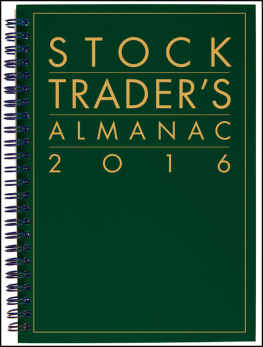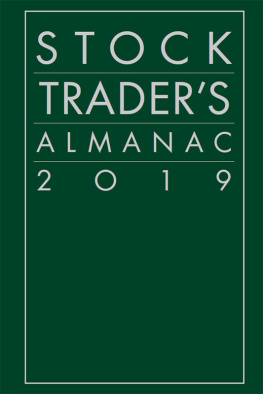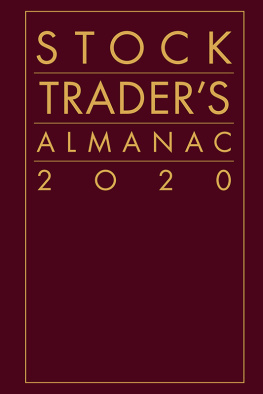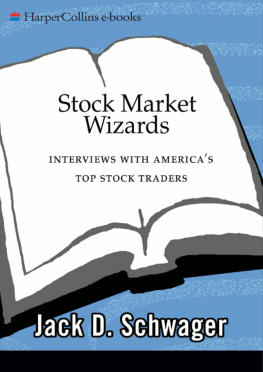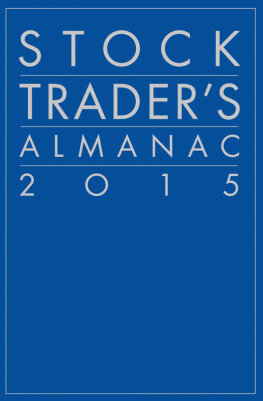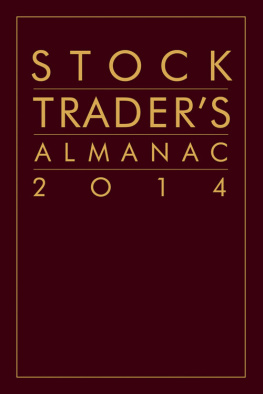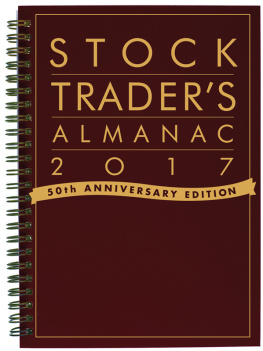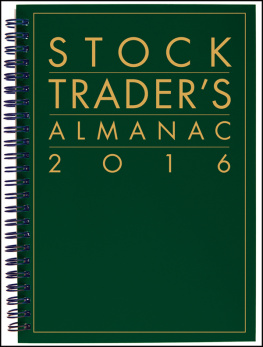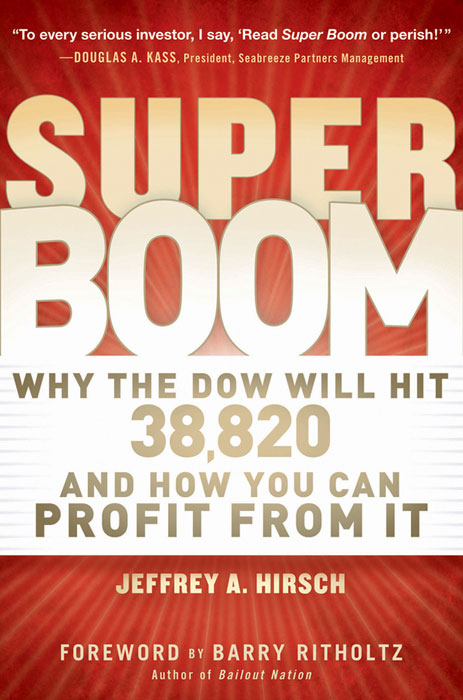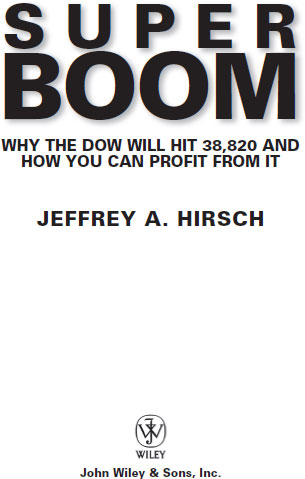Copyright 2011 by Jeffrey A. Hirsch. All rights reserved.
Published by John Wiley & Sons, Inc., Hoboken, New Jersey.
Published simultaneously in Canada.
No part of this publication may be reproduced, stored in a retrieval system, or transmitted in any form or by any means, electronic, mechanical, photocopying, recording, scanning, or otherwise, except as permitted under Section 107 or 108 of the 1976 United States Copyright Act, without either the prior written permission of the Publisher, or authorization through payment of the appropriate per-copy fee to the Copyright Clearance Center, Inc., 222 Rosewood Drive, Danvers, MA 01923, (978) 750-8400, fax (978) 646-8600, or on the Web at www.copyright.com . Requests to the Publisher for permission should be addressed to the Permissions Department, John Wiley & Sons, Inc., 111 River Street, Hoboken, NJ 07030, (201) 748-6011, fax (201) 748-6008, or online at http://www.wiley.com/go/permissions .
Limit of Liability/Disclaimer of Warranty: While the publisher and author have used their best efforts in preparing this book, they make no representations or warranties with respect to the accuracy or completeness of the contents of this book and specifically disclaim any implied warranties of merchantability or fitness for a particular purpose. No warranty may be created or extended by sales representatives or written sales materials. The advice and strategies contained herein may not be suitable for your situation. You should consult with a professional where appropriate. Neither the publisher nor author shall be liable for any loss of profit or any other commercial damages, including but not limited to special, incidental, consequential, or other damages.
For general information on our other products and services or for technical support, please contact our Customer Care Department within the United States at (800) 762-2974, outside the United States at (317) 572-3993 or fax (317) 572-4002.
Wiley also publishes its books in a variety of electronic formats. Some content that appears in print may not be available in electronic books. For more information about Wiley products, visit our web site at www.wiley.com .
ISBN 978-1-118-02470-6 (cloth); ISBN 978-1-118-07533-3 (ebk); ISBN 978-1-118-07534-0 (ebk); ISBN 978-1-118-07535-7 (ebk)
This book is humbly dedicated to Yale Hirsch, my illustrious father and mentorman of many talents, great thoughts, and big ideas. An iconoclastic market thinker, who made the greatest market call in history in 1976 for a 500 percent move in the market from the 1974 low to 1990. Thank you for giving me the business and all your love and support these past 44 years. Not only did you teach me the market, but you taught me how to appreciate all things in life. I proudly stand on your shoulders and prudently ride the coattails of your lifes work.
To my knowledge, Yale was the first to call the bottom of the last secular bear market in October 1974 and the first to predict the last super boom in March 1976.
Foreword
Nearly every trading desk on Wall Street has a copy of the Stock Traders Almanac on it. Thats not an exaggerationif you travel to the offices of enough Wall Street banks, mutual funds, and hedge funds, youll see plenty of dog-eared copies of the Almanac .
That is how I first met Jeff Hirschreading the STA . I began my career in finance working as a trader. In my first job on a trading desk, we newbies received very little training. We were thrown into the deep end of the pool, and if you managed to avoid drowningpoof!you were a trader. It was all very Darwinian.
Those of us who managed to survive learned quickly of the many things that affected how markets traded. Valuation, liquidity, sentiment, technical, and interest rate trends all moved stocks and bonds. But there was something larger at work that we did not see in the day-to-day trading. If you stepped back far enough to observe longer arcs of time, you could see a certain cycle. Indeed, it became apparent that markets moved with a certain rhythm, with variations of specific patterns repeating over and over again.
The Stock Traders Almanac was the first source I encountered that quantified these cycles. Whether it was the pattern of triple witch option expirations, or the seasonal best six months of the year, the STA provided a framework to view market history through the lens of repeating cycles.
History repeating (Rhyming, according to a quote attributed to Mark Twain) was the spark that sent me hunting for a broader view of how markets work. Why do stocks rise and fall? What factors drive short- and long-term prices? Why do valuations fluctuate so much?
Jeff and Yale Hirsch are the fatherson duo behind the Almanac . They each spent much of their careers as the editor/publisher of the bookYale from 19662000 and Jeff from 2000 to the present day. But they also have something else in common: They are students of market history. This has led them to rather nonmainstream understandings of the workings of the stock market. Seasonal data, longer-term trends, and historical cycles are part of their repertoire.
Besides the genetics, they have something else in common: Their understanding of secular markets and historical patterns has led each of them to make an outrageous forecast from the depths of a market collapse. The same historical, cyclical, and mathematical analyses underlay each of their predictions, made three and a half decades apart. Postwar peace dividends, excess inflation from war and crisis spending, and rapid adoption of new technologies are the factors that drove the prior secular market booms, and according to Jeff, will drive the next one as well.
Lets look at a bit of history: In the spring of 1976, in the middle of a terrible decade that saw very little progress in equities, rampant inflation, an oil embargo, several recessions, the end of a very unpopular war, and a presidential resignation, Yale Hirsch made a very unusual forecast. From those dark days of disco and polyester, he predicted a 500 percent move in the markets. Even more surprising, he hit the bulls-eye.
When you consider the context, it is an unlikely, even absurd forecast. The Dow had kissed 1,000 back in 1966. In 1974, it was still 40 percent below that level. Inflation was rampant, recessions seemed to come along every few years, and the country was still reeling from the double blows of Vietnam and Watergate. Ten years into what would turn out to be a 16-year period of zero market progress (19661982), the Dow was flat in nominal terms. Adjusted for inflation, it was down almost 45 percent.
How could Yale make such a forecast? The historian in him noticed something interesting about markets. It seemed that inflation surged during each of the world wars. That was followed by a 500 percent catch-up rally in equities after each war ended. With the end of the Vietnam War, could markets three-peat?
Indeed, that was the basis of Yales prediction: In a special report in Smart Money , he estimated that from the 1974 intraday low of Dow 570, the Dow would rise 500 percent by 1990, hitting 3,420. The S&P did gain 500 percent from its 1974 low to high in July 1990. The Dow crossed 3,420 in May 1992off by a few years, but all things considered, a terrific and money-making call.
Thirty-five years later, Yales son Jeff has made a similar forecast. According to the author of this book, the next super boom cycle will follow a decade of wars in Iraq and Afghanistan. It will send the Dow Jones to 38,820 by 2025.


